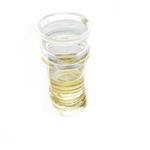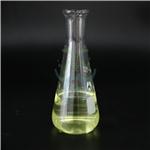- Phoxim
-

- $0.00 / 25KG
-
2023-06-30
- CAS:14816-18-3
- Min. Order: 1KG
- Purity: 99%
- Supply Ability: 50000KG/month
- Phoxim
-

- $10.00 / 1KG
-
2022-10-11
- CAS:14816-18-3
- Min. Order: 1KG
- Purity: 99%
- Supply Ability: 10 mt
- Phoxim
-

- $15.00 / 1KG
-
2021-07-13
- CAS:14816-18-3
- Min. Order: 1KG
- Purity: 99%+ HPLC
- Supply Ability: Monthly supply of 1 ton
|
| | Phoxim Chemical Properties |
| Melting point | 5.55°C | | Boiling point | bp0.01 102° | | density | d420 1.176 | | vapor pressure | 2.1×10-3 Pa (20 °C) | | refractive index | nD20 1.5405 | | storage temp. | 0-6°C | | solubility | Acetonitrile (Slightly), Chloroform (Slightly), Methanol (Slightly) | | Water Solubility | 1.5 mg l-1 (20 °C) | | form | liquid | | Stability: | Hygroscopic, Moisture Sensitive | | InChIKey | ATROHALUCMTWTB-WYMLVPIESA-N | | CAS DataBase Reference | 14816-18-3(CAS DataBase Reference) | | NIST Chemistry Reference | Phoxim(14816-18-3) | | EPA Substance Registry System | Phoxim (14816-18-3) |
| Hazard Codes | Xn;N,N,Xn | | Risk Statements | 22-50/53-62-43 | | Safety Statements | 36-60-61-46-36/37 | | RIDADR | UN 2810 | | WGK Germany | 3 | | RTECS | MD4740000 | | HazardClass | 6.1(b) | | PackingGroup | III | | HS Code | 29269090 | | Toxicity | LD50 orally in mice: >2000 mg/kg (Vinopal, Fukuto) |
| | Phoxim Usage And Synthesis |
| Description | Phoxim is a light yellow liquid, Solubility in water is 1.5 mg/L (20 ?C). It is readily soluble in most
organic solvents and slightly in aliphatic hydrocarbons.
Log Kow = 3.38. It is relatively slowly hydrolyzed in
aqueous media; DT50 (22 ?C) at pH 4, 7, and 9 is 26.7,
7.2, and 3.1 d, respectively. | | Chemical Properties | yellowish oily liquid, Specific gravity: 1.176 (20°C) | | Uses | Insecticide. | | Uses | Phoxim is used to control stored product insect pests in silos and
barns. It is also used to control household insects such as ants and other
public health pests. Agricultural targets include caterpillars and soil
insects in maize, vegetables, cotton and potatoes. | | Safety Profile | Poison by ingestion.
An experimental teratogen. When heated
to decomposition it emits very toxic fumes
of CN-, NO,, PO,, and SO,. See also
NITRILES. | | Metabolic pathway | The primary metabolic step in the metabolism of phoxim in most
biological systems is hydrolysis to the oxime, which may occur either
oxidatively or via oxidative desulfuration followed by hydrolysis of the
oxon which is much more hydrolytically labile. Stage II metabolism in
plants involves the oxime group of the oxaminophenylacetonitrile moiety
being reduced to an amine followed by its conjugation with malonic acid.
Phoxim is one of a quite large group of insecticidal organophosphates
which generates tetraethyl pyrophosphate and its thio analogues under
the influence of light. These are compounds which are very active as
acetylcholinesterase inhibitors and highly toxic to mammals. | | Metabolism | Phoxim is oxidatively
desulfurated to the oxon, which inhibits housefly AChE
270 times as quickly as bovine AChE. In mammals, the
oxon is immediately hydrolyzed into diethyl hydrogen
phosphate. The direct cleavage of the oxime ester bond of
phoxim, the hydrolytic transformation of the nitrile group
into carboxyl, and deethylation also contribute to the low
mammalian toxicity. Elimination is very quick, 97% of
the dose being excreted in the urine and feces in 24 h.
Degradation in soils is also very rapid. By photochemical
reactions, the thiooxime phosphate isomer, tetraethyl
pyrophosphate, and its monothio analog are produced in
small amounts on foliage. | | Degradation | Phoxim is relatively slowly hydrolysed in water. The half-lives at pH 4,7
and 9 were 26.7, 7.2 and 3.1 days, respectively (PM). Drager (1977)
reported a half-life of 145 min in pH 11.5 50% aqueous propanol at 37 °C.
It is gradually decomposed under UV irradiation (PM).
The photodecomposition of [32P]phoximon cotton leaves and glass
plates was investigated by Drager (1971) who characterised the more
hydrophobic organic-soluble components by TLC, GLC and 1H NMR and
MS of the purified products. The cotton plants were irradiated with
natural sunlight and mercury-vapour lamps at an average light intensity
of 3500-4000 lux. On both glass plates and irradiated cotton leaves,
phoxim was degraded relatively quickly to one major hydrophobic component,
the concentration of which reached a maximum after about one
day. This material was identified as the thiono-thiolo rearranged compound
O,O-diethyl a-cyanobenzylideneamino-thiophosphorothioate (2).
This transformation is an activation step as 2 is a highly active acetylcholinesterase
inhibitor. No metabolite 2 was formed on cotton leaves
placed in the dark so it can be considered to be a photochemical product
rather than a plant metabolite. Additional minor metabolites were tetraethyl
pyrophosphate (3) and O,O,O',O'-tetraethyl thiophosphorothioate
(4) which formed to a greater extent on the glass plates rather than the
cotton leaves. | | Toxicity evaluation | The acute
oral LD50 for rats is >2000 mg/kg. Inhalation LC50 (4 h)
for rats is >4.0 mg/L air. NOEL (2 yr) for rats is 15 mg/kg
diet (0.75 mg/kg/d). ADI is 1 μg/kg b.w. |
| | Phoxim Preparation Products And Raw materials |
|